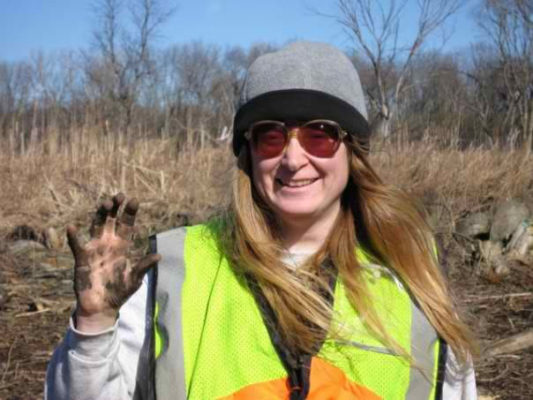The Resource Ecology Division of the Forest Preserves of Cook County has a lot of ground to cover—literally. Chief Ecologist Chip O’Leary oversees four other ecologists, each of whom oversees roughly a quarter of the District’s almost 69,000 acres, more than 80 percent of which are natural lands. The ecologists provide professional support and guidance to District staff and volunteer stewards, conduct research, develop habitat management plans and evaluate the impact that proposed projects (such as a new campsite or pavilion) could have on ecosystems in the forest preserves.
We asked Northwest Region ecologist Deborah Antlitz to share a typical day. Her region includes places such as the Spring Creek watershed, Poplar Creek watershed, Bluff Spring Fen, Deer Grove and the northern stretch of the Des Plaines River. This day starts off not with flower pollination, as one might expect, but with cross-pollinating ideas with colleagues in the big city:
Deborah Antlitz in the Great Northwest

My day begins with an early morning commute downtown to the US Environmental Protection Agency in Chicago, for a meeting of the Chicago Wilderness Natural Resources Management Team. Gathered together are experts in science and land management from around the region, including the US Fish & Wildlife Service, the Environmental Protection Agency, Morton Arboretum, Illinois Department of Natural Resources, Chicago Botanic Garden, Audubon, Illinois Nature Preserves Commission, local volunteer and community groups, and ecologists and managers from other counties such as Lake, McHenry, DuPage, Will, Kane, and neighboring states Indiana and Wisconsin. We discuss the latest developments and discoveries that may affect us all, including the Green Infrastructure Vision, an initiative that works to connect open spaces across northeast Illinois and the southern Great Lakes. Although the concept of “green infrastructure” is relatively new, I think about how in many ways the Forest Preserve District of Cook County has actually been participating in this project for a century.
For the afternoon, it’s out to the field, to the beautiful McMahon Fen in the Palos area, home to the federally endangered Hine’s Emerald Dragonfly and known for its diversity of butterflies. The District partners with the US Army Corps of Engineers, Openlands, the Butterfly Monitoring Network, US Fish & Wildlife Service, and Palos volunteers in restoring more than 100 acres of formerly brushed-over land back to healthy, rare fen, prairie and savanna habitat. We are here to evaluate the District’s use at this site of prescribed burns, which it regularly uses as a management tool in fire-adapted habitats across the county. Doug Taron from the Peggy Notebaert Nature Museum meets me, along with Linda Masters from Openlands. We walk the site, and Doug points out the impressive abundance of silver-spotted checkerspots on the site. He points out other rare species as well, some last observed at the turn of the 20thcentury.
Fire is a vital element in the health and recovery of this grass- and sedge-dominated wetland, prairie and savanna complex. It will keep the invasive brush from coming back and clear the dead thatch so that fresh grass and wildflowers can thrive in the sunlight. But fire can also burn insects that wait out the winter in that thatch, and here we have some rare butterflies whose larvae require extra caution. We discuss the need to create burn refugia, areas that remain unburned to provide a safe haven for butterflies that overwinter in the flammable thatch. Later I will coordinate with the site steward Joe Neumann, who knows all the locations of uncommon plants on which some of these butterflies depend. We work together to develop a refuge that protects portions of the host plants and overwintering areas.
Later that afternoon I pay a visit to some fixed monitoring stations at Crabtree Nature Center in Barrington. Here in the woodlands 20 years ago I set stakes around several plots on the ground. Within these small areas I counted and tracked the flowering health of a couple hundred wildflowers. Over the years I watched as buckthorn, an invasive European shrub, slowly encroached on these areas, causing the wildflowers to cease to bloom in the thickening shade. Eventually they failed to emerge and have been languishing for the past decade.
But this past winter, with the District bringing additional resources to habitat restoration, contractors at long last removed all the buckthorn. The woods are beautifully open now. No more a wall of buckthorn, I can see the gentle rolling topography of the glacial hills, the slope of the wetland basin beyond, the rise of the more level prairie across the little pond and marsh. For the first time in a long time, the ground is green with wildflowers again. I carefully walk amongst the lush foliage, part the vegetation and locate the telltale stakes of my established plots. Some spots have succumbed to the long buckthorn siege, but a good number of my old wildflower friends are there, stretching their new and hopeful leaves toward the renewed sunlight, free at last. In time they will recover, grow and thrive, put out blooms and establish seeds of their own that the ants will gather and scatter across the wooded hillsides. In coming years, these springtime woods will sport the demure white blooms of trout lily, the rich burgundy of trillium, the feathery flair of the starry Solomon’s seal and the pink radiance of wild geranium.
I and my fellow ecologists know we’re on a long trek in the effort to protecting and restoring our natural areas. Today is a single step, but an important one, on the road toward brighter days for our local ecosystems.
Deborah Antlitz is a Forest Preserves ecologist.
